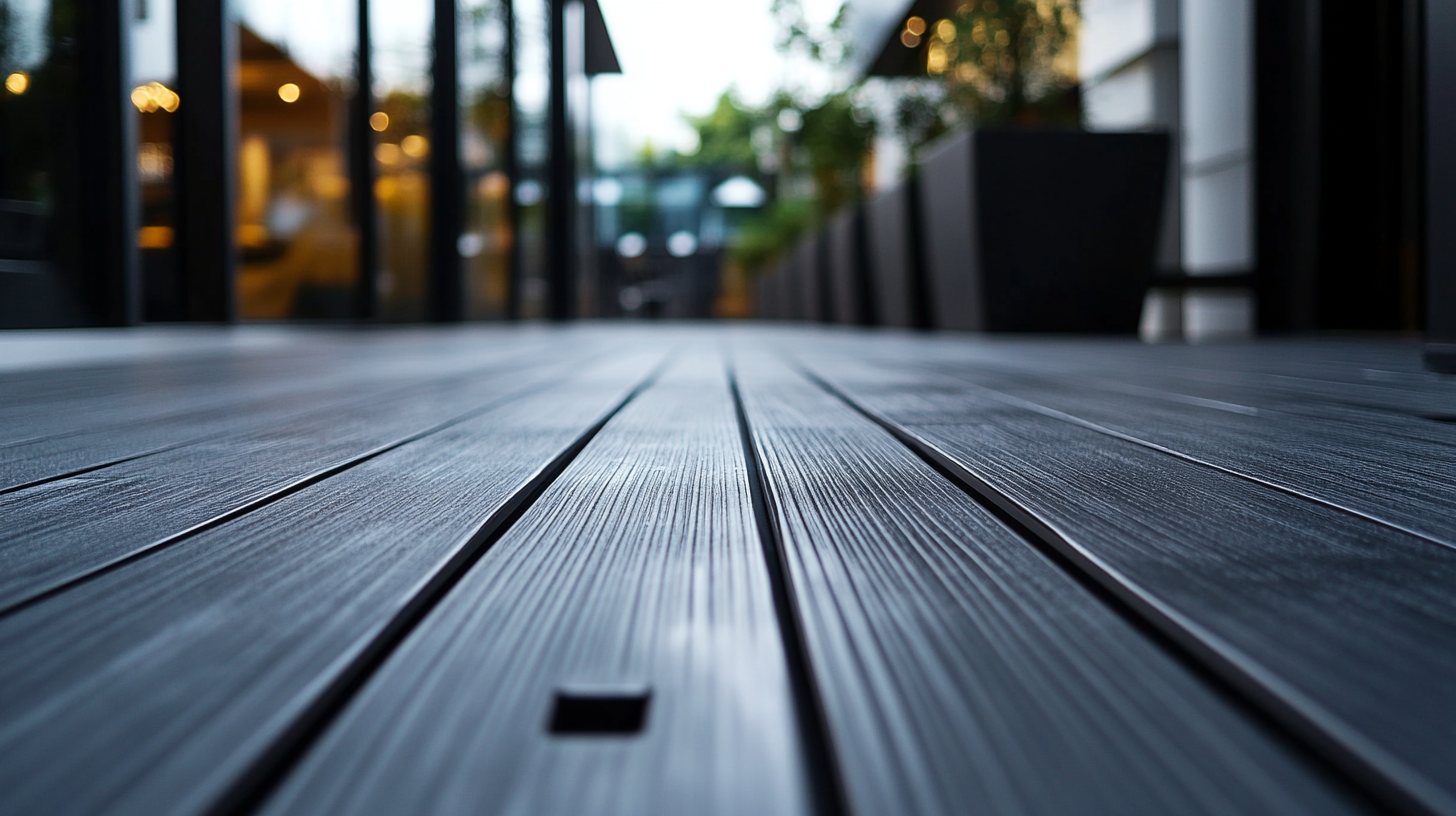
As the global demand for sustainable and durable building materials continues to rise, WPC decking has emerged as a leading solution for both residential and commercial applications. According to a recent report by Smithers Pira, the global WPC market is projected to reach $6.3 billion by 2026, driven by an increasing preference for eco-friendly alternatives to traditional wood and plastic materials. With China being a major player in the production of WPC decking, it has established itself as an export powerhouse, reflecting its commitment to quality and innovation. This guide aims to navigate the various aspects of choosing the best WPC decking for your business needs, ensuring that you leverage these advancements to enhance your projects and meet consumer demands effectively.

When selecting WPC (Wood Plastic Composite) decking for your business, there are key factors to consider that can significantly impact both performance and aesthetics. First and foremost, durability is paramount. According to a recent report by Freedonia Group, WPC decking is projected to witness a compound annual growth rate (CAGR) of 11.2% through 2024, primarily due to its resistance to decay, insects, and moisture. This durability is crucial for commercial applications where heavy foot traffic or exposure to the elements can quickly degrade inferior materials.
Another essential factor is the environmental impact of the decking material. Recent studies highlighted in the 2022 Sustainable Materials Review show that WPC products can significantly reduce carbon footprints when sourced from recycled materials. Many retailers now prioritize eco-friendly options; thus, businesses keen on sustainability can leverage the growing consumer demand for greener products. An estimated 70% of consumers consider sustainability as a key buying factor. Therefore, selecting WPC decking not just for its physical properties but also its environmental benefits can offer a competitive edge in today's market.
 WPC (Wood-Plastic Composite) decking has gained significant traction in the construction industry, particularly for outdoor applications. One of the primary advantages of WPC decking over traditional materials like wood and concrete is its remarkable durability. According to the Freedonia Group, WPC decking is resistant to rot, insects, and moisture damage, which can extend its lifespan by up to 30 years compared to conventional wood decking that may require frequent replacements due to wear and tear.
WPC (Wood-Plastic Composite) decking has gained significant traction in the construction industry, particularly for outdoor applications. One of the primary advantages of WPC decking over traditional materials like wood and concrete is its remarkable durability. According to the Freedonia Group, WPC decking is resistant to rot, insects, and moisture damage, which can extend its lifespan by up to 30 years compared to conventional wood decking that may require frequent replacements due to wear and tear.
Another key benefit lies in the environmental aspect. The North American Deck and Railing Association (NADRA) reported that WPC is primarily made from recycled materials, making it a more sustainable option. This not only reduces the consumption of natural resources but also minimizes landfill waste. Furthermore, WPC decking requires less maintenance, often needing just occasional cleaning to keep it looking new, while traditional wooden decks demand regular staining and sealing. This lower maintenance requirement translates to cost savings and less labor over time, highlighting why many businesses are opting for WPC as a superior choice for their decking needs.
When selecting WPC (Wood Plastic Composite) decking for your business needs, evaluating the quality is crucial. One of the essential criteria to consider is the material composition. Research indicates that high-quality WPC decking consists of a blend of at least 60-70% wood fiber, which enhances durability while offering a natural appearance. Notably, the Wood Plastic Composite Market is projected to reach $7.3 billion by 2027, highlighting a growing demand for sustainable and durable materials.
Another important factor is the moisture resistance of the decking. According to the Composite Wood Decking Market Trends report, moisture-related issues can diminish the lifespan of the product, making water resistance pivotal. Look for WPC products that are rated for low water absorption, ideally less than 5%, to ensure longevity. Additionally, check the warranty terms; reputable manufacturers typically offer warranties between 20 to 30 years, which reflect their confidence in material quality and durability under various weather conditions. This information can guide businesses in making informed choices for their decking solutions.
When it comes to WPC (Wood-Plastic Composite) decking, several misconceptions can cloud the decision-making process for businesses. One common myth is that WPC decking has a shorter lifespan compared to traditional wood. However, according to a report by Freedonia Group, WPC decking can last up to 25 years with proper maintenance, significantly outpacing untreated lumber, which typically deteriorates within 10-15 years due to moisture and pest damage.
Another prevalent misunderstanding is that WPC decking requires excessive maintenance. In reality, WPC boards are designed to be low-maintenance, needing only occasional cleaning with soap and water. A study by the American Wood Council highlights that WPC products resist splintering and warping, cutting down on upkeep and making them a practical choice for high-traffic business areas. This durability means businesses can focus more on productivity rather than flooring concerns.
Moreover, some believe that WPC decking is significantly more expensive than traditional options. While the upfront cost can be higher, data from the North American Deck and Railing Association indicates that the long-term savings from reduced maintenance and replacement costs often make WPC decking a more economical choice over time.
| Misconception | Truth | Impact on Business | Recommendation |
|---|---|---|---|
| WPC Decking is Expensive | WPC decking can be cost-effective over time due to low maintenance. | Higher initial cost may deter some businesses, affecting sales. | Evaluate long-term benefits and total cost of ownership. |
| WPC is Not Environmentally Friendly | Many WPC products are made from recycled materials. | Misconceptions can harm brand reputation. | Promote sustainability practices in marketing. |
| WPC Decking is Not Durable | WPC decking is highly resistant to decay and pests. | Potential for increased maintenance costs and replacements. | Educate customers about durability features. |
| WPC Decking Requires Special Care | WPC is easy to clean and maintain like traditional wood. | Fear of complicated maintenance can deter purchases. | Highlight the ease of cleaning in promotional materials. |
| WPC Decking is Only for Residential Use | WPC decking is versatile and suitable for commercial projects. | Limited market perception can impact sales opportunities. | Promote applications in different sectors like hospitality. |
When selecting WPC decking for your business, sustainability should be a primary consideration. As consumers increasingly favor eco-friendly products, choosing sustainable materials can enhance your brand image and appeal to environmentally-conscious customers. According to a 2021 industry report by the Freedonia Group, the demand for sustainable building materials is projected to grow by over 10% annually, as builders and designers aim to reduce their carbon footprints and meet green certification standards.

WPC (Wood Plastic Composite) decking stands out due to its environmentally friendly composition, often made from recycled wood fibers and plastic. A study by the Recycled Materials Resource Center revealed that using recycled content in WPC products can reduce waste while significantly lowering greenhouse gas emissions compared to traditional decking materials. Furthermore, WPC decking tends to have a longer lifespan and lower maintenance requirements, contributing to sustainability by reducing the frequency of replacement and repair, which in turn conserves resources.
As businesses shift towards sustainable practices, investing in high-quality WPC decking aligns with global trends towards greener construction. By choosing decking that incorporates recycled materials and is designed for durability, businesses not only contribute to environmental conservation but also position themselves as leaders in the emerging sustainable market.
